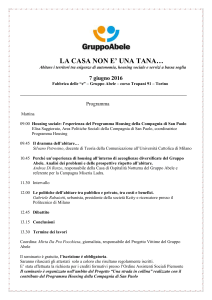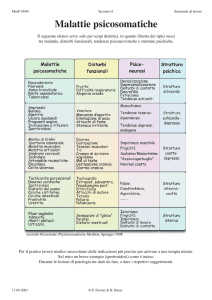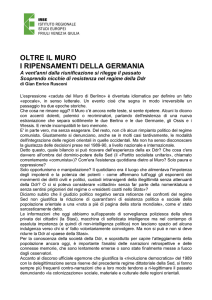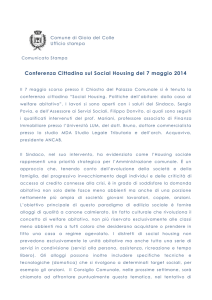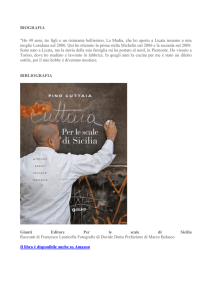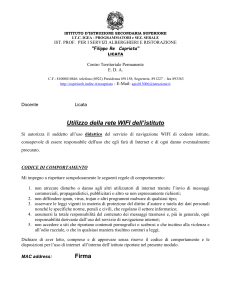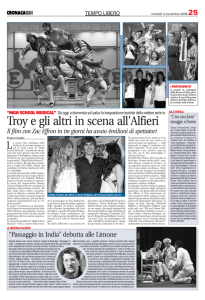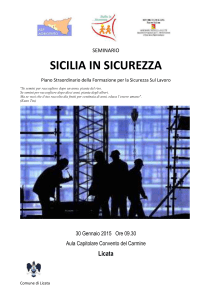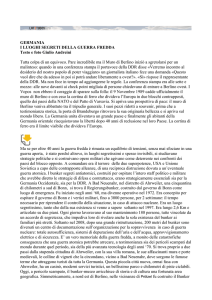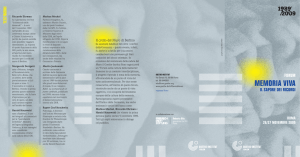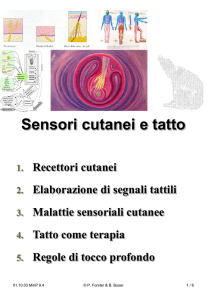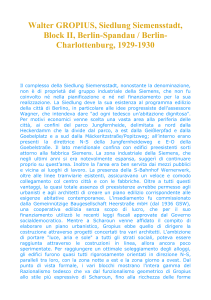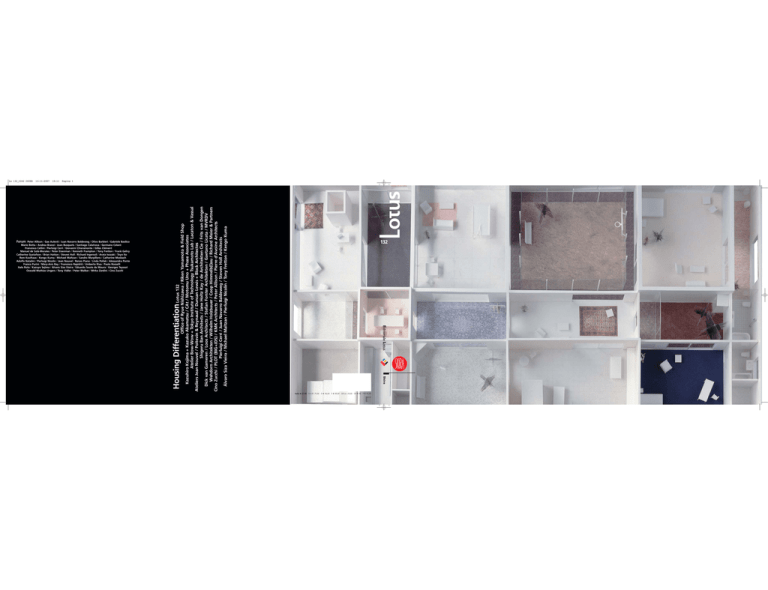
10:11
Pagina 1
Forum Peter Allison / Gae Aulenti / Juan Navarro Baldeweg / Olivo Barbieri / Gabriele Basilico
Mario Botta / Andrea Branzi / Joan Busquets / Santiago Calatrava / Germano Celant
Francesco Cellini / Pierluigi Cerri / Giovanni Chiaramonte / Gilles Clément
Manuel de Solà-Morales / Peter Eisenman / Kenneth Frampton / Tony Fretton / Frank Gehry
Catherine Gustafson / Brian Hatton / Steven Holl / Richard Ingersoll / Arata Isozaki / Toyo Ito
Rem Koolhaas / Kengo Kuma / Michael Maltzan / Sandro Marpillero / Catherine Mosbach
Adolfo Natalini / Pierluigi Nicolin / Jean Nouvel / Renzo Piano / Linda Pollak / Alessandra Ponte
Franco Purini / Mary-Ann Ray / Francesco Repishti / Umberto Riva / Paolo Rosselli
Italo Rota / Kazuyo Sejima / Álvaro Siza Vieira / Eduardo Souto de Moura / Georges Teyssot
Oswald Mathias Ungers / Tony Vidler / Peter Walker / Mirko Zardini / Cino Zucchi
Office of Ryue Nishizawa / Riken Yamamoto & Field Shop
Kazuhiro Kojima + Kazuko Akamatsu / CAt / Motomu Uno + Phase Associates
Atelier Bow-Wow + Tokyo Institute of Technology Tsukamoto Lab / Lacaton & Vassal
Ateliers Jean Nouvel / Poitevin & Reynaud / Duncan Lewis + Block Architectes
Shigeru Ban Architects / Jane Holtz Kay / de Architekten Cie / Frits van Dongen
Dick van Gameren / Loos Architects / Stefan Forster Architekten / Gaetano Licata / MVRDV
Wehdorn Architekten / Wilhelm Holzbauer / Coop Himmelb(l)au / Richard Meier & Partners
Cino Zucchi / PLOT (BIG+JDS) / KMK Architects / Peter Allison / Pierre d’Avoine Architects
Pierluigi Cerri / Juan Navarro Baldeweg / Steven Holl Architects
Álvaro Siza Vieira / Michael Maltzan / Pierluigi Nicolin / Tony Fretton / Kengo Kuma
13-11-2007
132
Skira
Housing Differentiation Lotus 132
Lo 132_C2S2 COVER
Italia € 27,00 CH Sfr. 75,00 D € 56,00 E € 49,00 GB Lst. 29,00 GR € 46 P € 45,40
065_070 Lo 132 C2S1 forster
6-11-2007
14:50
Pagina 65
Dalla stecca alle ville/From Rib to Villas
Effetti del cambio ideologico nella ex DDR
Effects of ideological change in the former DDR
065_070 Lo 132 C2S1 forster
6-11-2007
13:39
Pagina 66
Gaetano Licata
Da Plattenbau a Ville Urbane/From Plattenbau to Urban Villas
Negli anni Sessanta Leinefelde si presentava come un piccolo paese ai margini della Ddr. A seguito del piano statale Eichsfeldplan1 del 1959 il paese si trasformò in polo industriale, con una crescita della popolazione da circa
2.200 a 16.500 abitanti nell’arco di soli venti anni. Per rispondere a questo incremento demografico fu realizzata
la Siedlung Leinefelder Südstadt, un quartiere di circa
4850 abitazioni costruito utilizzando sistemi di prefabbricazione pesante (Plattenbau) secondo la pratica dell’urbanistica socialista. Alla base della costruzione di siedlungen di questo tipo vi era il principio costituzionale che considerava l’abitazione come un bene sociale da assicurare
alla classe operaia, compito di cui lo Stato si faceva carico2.
In questa logica la standardizzazione tipologica e costruttiva governava normativamente la progettazione architettonica e urbanistica3. Con la caduta del Muro di Berlino
nel 1989 e l’introduzione del libero mercato, le industrie
di Leinefelde non risultarono più competitive, con la conseguenza di un progressivo esodo degli abitanti verso la
Germania Ovest e il relativo abbandono di circa un terzo
delle abitazioni della siedlung.
Già a partire dagli anni Novanta la città di Leinefelde, a differenza di altre città dell’ex Ddr4, affrontò questo problema in maniera radicale, tramite programmi integrati di demolizioni e trasformazioni, regolati da un masterplan che
si distinse per l’approccio sperimentale e innovativo, superando le tanto dominanti logiche urbanistiche quantitative. Nell’ambito di questa operazione lo studio Forster
di Francoforte, già vincitore di un concorso a Leinefelde,
fu incaricato da società immobiliari del luogo della trasformazione di uno degli edifici della siedlung. Si trattava
di un edificio in linea di 5 piani, costruito secondo il più sviluppato tipo di prefabbricato pesante, il WBS705, con
pannelli sandwich assemblati nei nodi attraverso ancoraggi in acciaio e getto di calcestruzzo. L’intero edificio era
stato costruito secondo un unico modulo abitativo di 12
metri ripetuto quindici volte sul lato lungo, con appartamenti, 150 in totale, di tre e quattro vani. Al momento
dell’incarico, le facciate erano in uno stato di degrado evidente, gli spazi esterni circostanti erano indifferenziati e
non curati.
66
Trasformazione
«Il blocco lineare abitativo in prefabbricato pesante di 180
metri di lunghezza, attraverso la demolizione dell’ultimo
piano e di sette moduli intermedi, è stato trasformato in
otto Ville Urbane di quattro piani»6. La sottrazione dei
tratti intermedi è avvenuta alternativamente secondo la
griglia strutturale dell’edificio, dando vita a un ritmo regolare di campi chiusi e aperti ognuno di 12 metri di larghezza: degli originari 150 appartamenti se ne conservano solo 63, con una diminuzione superiore al 50% del volume preesistente. Possiamo definire il concetto base di
questo processo di trasformazione come il passaggio da
un sistema lineare a un sistema puntuale.
Ma quali sono state le conseguenze dell’operazione sul
piano architettonico e urbano? L’edificio esistente mantiene la sua posizione di bordo lungo la strada di accesso,
ma dopo le sottrazioni eseguite acquisisce un rinnovato
ruolo urbano di ingresso alla siedlung: si formano dei
grandi varchi che permettono un nuovo rapporto con il
paesaggio circostante e rendono contemporaneamente
visibile lo spazio interno della rinnovata siedlung; alla base di questi varchi si formano dei nuovi spazi pubblici intermedi in forma di plateaux di accesso alle singoli “ville”.
Le sottrazioni di volumi provocano l’oggettivazione dei
corpi di fabbrica rimanenti: essi, diventati oggetti (ville),
possono essere differenziati tra loro nella forma; ogni singola villa conquista quattro facciate libere: tutte le stanze
degli appartamenti, compresi i servizi, ricevono luce naturale; le piante possono essere variate consentendo l’individualizzazione di diverse tipologie di appartamenti; nuovi gradi di libertà arricchiscono la composizione delle facciate: le aperture e i balconi, diversamente da prima, non
corrispondono a tutti i piani, ma assecondano la distribuzione interna; ai piani terra gli appartamenti sono dotati
di piccoli giardini con un accesso indipendente direttamente da questo, così da contribuire a una ulteriore individualizzazione. Il mantenimento di tutto il piano seminterrato, che ospita gli impianti tecnici centralizzati, permette di segnare il bordo della siedlung sulla strada fuoriuscendo dalla linea di terra di circa un metro. I corpi scala esistenti sono stati mantenuti come unici collegamenti
verticali per ogni singola villa: il quinto livello è demolito
perché il suo mantenimento avrebbe reso obbligatoria
l’installazione di un ascensore per ogni villa.
Alla apparente semplicità e coerenza concettuale dell’operazione di sottrazione effettuata sul sistema prefabbricato corrispondono in realtà varie difficoltà pratiche e costruttive. La demolizione dei tratti intermedi ha notevolmente intaccato la stabilità che offrivano gli elementi trasversali, divenuti dopo la demolizione facciate esterne. Per
aumentare la rigidità e la controventatura del sistema si è
reso necessario applicare degli anelli perimetrali metallici
di consolidamento per ogni piano, e realizzare un nuovo
muro in calcestruzzo armato gettato in opera, come raddoppio di uno degli elementi prefabbricati trasversali. Anche l’ancoraggio dei nuovi balconi è una operazione costruttiva complessa, per la necessità di fissarli non solo agli
elementi prefabbricati di facciata, ma anche ai solai per
mezzo di mensole di acciaio. Tutte queste operazioni di
natura strutturale sono state eseguite in modo da non risultare percepibili a cantiere finito riducendo al massimo i
giunti e i dettagli costruttivi visibili. Ciò è stato facilitato da
un rivestimento continuo di tutte le facciate con uno strato di coibentazione termica che assolve un’altra delle condizioni per il progetto di trasformazione: l’adeguamento
alle attuali norme in materia di miglioramento del bilancio
energetico.
Dal punto di vista dell’immagine finale, è negato ogni diretto legame con l’aspetto originario dell’edificio, liberando consapevolmente il progetto da temi quali il rapporto
tra il vecchio e il nuovo, tipici dell’intervento su edifici storici. Il concetto progettuale e la sua espressione figurativa
mettono al centro le nuove singole ville pensate come
grandi sculture giacenti su un piano comune, le quali si
differenziano tra loro attraverso variazioni di volume e colore, ma che proprio attraverso queste regole di variazione comuni, vengono a formare una unità riconoscibile.
Da due a tre dimensioni
Possiamo identificare l’edificio originario in prefabbricato
pesante come il risultato di una composizione bidimensionale fondata sulla ripetizione e sull’assemblaggio. I suoi
elementi-base prefabbricati (Großtafel) infatti, sono caratterizzati da due dimensioni prevalenti, tanto da potere
essere assimilati a delle superfici. Nel progetto di trasformazione è riproposto lo stesso tema compositivo, la ripetizione e l’assemblaggio di pochi elementi, in questo caso
tridimensionali. I nuovi elementi-base sono da un lato i volumi risultanti dalle demolizioni e dall’altro gli aggetti dei
balconi, i quali interagendo tra loro, formano unità completamente nuove e uniche. Il rapporto volumetrico tra i
due elementi-base, le ombre che essi si proiettano reciprocamente e le variazioni di colore dei prospetti, danno
alla composizione un carattere quasi costruttivista, che
evoca reminiscenze esteuropee.
Cambio di paradigma
Indipendentemente dall’aspetto specificatamente architettonico, la trasformazione di un grande edificio collettivo per abitazioni in più edifici abitativi individualizzati, rispecchia il cambiamento politico-sociale che la ex DDR e
la sua popolazione hanno vissuto nel corso di pochissimi
anni. I principi urbanistici e sociali che stavano alla base di
questo tipo di Siedlungen sono sicuramente da ricercare
nel Movimento moderno, almeno in riferimento al ruolo
che si attribuiva all’architettura nel contribuire alla formazione della nuova società. Dopo la caduta del Muro questi presupposti politici e ideologici furono ritenuti superati, il ruolo centrale e prevalente della società come entità
fu sostituito da quello di una pluralità di individui. A questo cambiamento di paradigma politico e sociale corrisponde una mutazione nei desideri e nei riferimenti degli
abitanti rimasti: essi assunsero lo stile di vita dell’Ovest,
quindi anche il modo di abitare, come meta da raggiungere, il più presto possibile e superando lo scarto culturale, politico, sociale di circa mezzo secolo.
In questo contesto di nuove condizioni e desideri, nel caso di Leinefelde, l’architetto – mediatore tra il committente e i futuri inquilini – ha cercato un modello rispondente
sia ai desideri di individualità degli abitanti che alle strategie di mercato, proponendo la Punkthaus, un tipo urbano
molto diffuso e attuale nella Germania dell’Ovest che offrisse un compromesso tra l’unicità della casa singola – come il massimo dell’identificazione – e l’idea di abitazione
collettiva, sebbene con un numero molto limitato di unità
abitative.
065_070 Lo 132 C2S1 forster
13-11-2007
11:25
Pagina 67
Stefan Forster Architekten
Stadtvillen
Leinefelde-Worbis, Deutschland, 2000-04
Stefan Forster
Con/With: Reinhardt Mayer, Nikolaus Neufeldt
Foto di/Photos by: Jean-Luc Valentin
Scorci dell’edificio prima, durante e dopo l’intervento
e diagrammi delle fasi di progetto (Gaetano Licata)
Views of the building before, during and after the
intervention and diagrams of the phases in the project
(by Gaetano Licata)
Il progetto ha interessato la trasformazione
di un edificio in linea, lungo 200 metri, in una serie
di otto edifici con affacci su tutti i quattro lati.
La stecca costruita con elementi prefabbricati
è stata letteralmente “tagliata” creando
spazi aperti, passaggi e giardini.
The project entailed the transformation
of a 200-meter-long linear building into a series
of eight buildings with openings on all four sides.
The rib constructed from prefabricated elements
has been literally “sliced,” creating open spaces,
passages and gardens.
67
065_070 Lo 132 C2S1 forster
13-11-2007
11:26
Pagina 68
Piani paralleli
La forza di questa trasformazione sta nella semplicità con
cui è possibile descrivere il cambiamento di significato avvenuto: da siedlung prefabbricata a ville urbane. Non si
tratta di un procedimento formale, ma di un concetto integrato che rifiuta il risultato come somma di risposte singole alle diverse condizioni che sono cambiate: desideri
dei residenti, strategie di mercato, struttura sociale, qualità residenziale, standard tecnici.
Ogni singola decisione progettuale agisce parallelamente
e contemporaneamente su più piani: i nuovi balconi, che
rispondono alle esigenze di mercato, sono un elemento
compositivo e contribuiscono all’individualizzazione di
ogni singola villa o abitazione; la coibentazione termica,
una necessità dal punto di vista energetico, copre tutte le
irregolarità preesistenti e gli interventi di consolidamento
e dà vita a una superficie omogenea che determina l’aspetto finale; il piano seminterrato continuo forma un basamento unitario e nell’economia dello spazio esterno dà
vita ai plateaux di ingresso per ogni singola villa. Nel rapporto con il preesistente è l’elemento più resistente che
svela la doppia operazione di lavorare nello stesso tempo
a un intero edificio e a singole parti nuove. Questo tipo di
approccio al progetto di trasformazione, sebbene relativo a una tipologia molto specifica, al di là della sua risposta strettamente architettonica, concretizza la trasformabilità come disposizione propria dell`architettura moderna corrente e apre nuovi ambiti applicativi e di riflessione
nel progetto di architettura.
68
In the sixties Leinefelde was a village on the edges of
the DDR. Following the Eichsfeldplan1 of 1959, the village
was turned into an industrial center, with an increase in
the number of inhabitants from around 2,200 to 16,500
over the space of just twenty years. In response to this increase in population the Siedlung Leinefelder Südstadt
was built, a project of around 4,850 houses constructed
using systems of slab prefabrication (Plattenbau), a practice typical of socialist city planning. At the base of the
construction of Siedlungen or housing projects of this
type was the constitutional principle that held housing to
be a social good which had to be guaranteed to the
working class, a responsibility assumed by the State.2 In
this logic standardization of typology and construction
prescriptively regulated architectural and urban design.3
Following the collapse of the Berlin Wall in 1989 and the
introduction of the free market, the industries of Leinefelde were no longer competitive, resulting in a progressive exodus of the inhabitants to West Germany and the
abandonment of about a third of the housing units in
the Siedlung.
As early as the nineties the town of Leinefelde, unlike
other towns and cities in the former DDR,4 tackled this
problem in a radical manner, through integrated programs of demolition and conversion, governed by a masterplan that distinguished itself by its experimental and
innovative approach, going beyond the dominant quantitative logic of city planning. As part of this operation the
Forster studio of Frankfurt, which had previously won a
competition in Leinefelde, was commissioned by local real-estate companies to transform one of the buildings in
the Siedlung.
This was a linear building of five stories, constructed using the most advanced type of slab prefabrication, the
WBS70,5 with sandwich panels assembled at the junctions with steel anchors and castings of concrete. The entire building had been constructed on a single housing
module of 12 meters, repeated 15 times on the long side,
with a total of 150 apartments of three and four rooms.
At the time of the commission, the façades were in an
obvious state of decay and the surrounding external
spaces were undifferentiated and neglected.
Conversion
“Through the demolition of the top story and of seven intermediate modules, the 180-meter-long linear housing
block constructed by slab prefabrication has been converted into eight four-story-high Urban Villas.”6 The removal of the intermediate sections was carried out in alternation, according to the structural grid of the building,
producing a regular pattern of closed and open sections,
each with a length of 12 meters: of the original 150
apartments only 63 have been retained, a reduction of
over 50% in the preexisting volume. We can define the
basic concept of this process of transformation as the
shift from a linear system to a point system.
But what have been the consequences of the operation
on the architectural and urban plane? The existing building maintains its position along the edge of the access
road, but after the removal of the sections it has acquired
a new urban role of entrance to the Siedlung: large openings have been formed that permit a new relationship
with the surrounding landscape and at the same time
make the space inside the renovated Siedlung visible; at
the base of these openings new intermediate public
spaces have been created in the form of plateaux of access to the individual Villas. The removal of volumes results in the objectification of the remaining sections of
the building: these, having become objects (Villas), can
be differentiated from one another in their form. Each individual Villa now has four free façades: all the rooms of
the apartments, including the bathrooms and kitchens,
receive natural light. The plans can be varied, permitting
the individualization of different types of apartment.
New degrees of freedom enrich the composition of the
façades: the openings and the balconies, unlike before,
are not the same on each floor, but follow the internal
distribution. On the ground floors the apartments have
small gardens and independent entrances directly from
these gardens, contributing to a further individualization.
The retention of the whole basement level, which houses
the centralized technical plant, has made it possible to
mark the boundary of the Siedlung on the road by having it emerge about a meter above the ground line. The
existing stair blocks have been maintained as the only
vertical connections for each Villa: the fifth level has been
demolished as its retention would have required the installation of an elevator for each Villa.
065_070 Lo 132 C2S1 forster
13-11-2007
11:28
Pagina 69
Planimetrie, veduta dall’alto, scorci dei due fronti principali
Site plans, overhead view and views of the two main fronts
L’intervento, che ha interrotto la continuità dell’edificio
preesistente, ha adottato l’uso del colore
e dei balconi come nuovi elementi compositivi.
Dall’idea dell’alloggio uguale per tutti si è passati
alla differenziazione delle singole unità.
The intervention, which has interrupted the continuity
of the existing building, has made use of color and
balconies as new elements of composition. A shift
from the idea of the same housing for everyone
to the differentiation of individual units.
065_070 Lo 132 C2S1 forster
6-11-2007
13:36
Pagina 70
The apparent simplicity and conceptual coherence of the
operation of subtraction carried out on the prefabricated
system brought in reality a series of practical and structural difficulties. The demolition of the intermediate sections has considerably impaired the stability provided by
the transverse elements, which have been turned into
outer façades. To increase the rigidity and the bracing of
the system it became necessary to apply external metal
rings of consolidation on each floor, and to build a new
wall of reinforced concrete cast on site to strengthen one
of the transverse prefabricated elements. The anchorage
of the new balconies has also been a complicated structural operation, owing to the need to fix them not only
to the prefabricated elements of the façade but also to
the floor slabs, by means of steel brackets. All these operations of a structural nature have been done in such a
way that they are not perceptible once the construction
process has been completed, reducing the visible joints
and structural details to the minimum possible. This has
been facilitated by a continuous facing of all the fronts
with a layer of thermal insulation that meets another of
the conditions for the project of conversion: compliance
with current standards aimed at improvement of the energy budget.
From the viewpoint of the final image, any direct link with
the original appearance of the building has been ruled
out, with the deliberate intention of freeing the design
from themes like the relationship between old and new,
typical of interventions in historic buildings. The planning
concept and its figurative expression place the new, individual Villas at the center, treating them as large sculptures lying on a common plane, differentiated from one
another through variations in volume and color, but
which come to form a recognizable unity precisely
through these common rules of variation.
70
From Two to Three Dimensions
We can identify the original building constructed by the
method of slab prefabrication as the result of a twodimensional composition founded on repetition and assemblage. In fact its prefabricated base elements
(Großtafel) are characterized by the predominance of
two dimensions, to the point where they can be likened
to surfaces. In the project of conversion the same theme
of composition is proposed again, with the repetition and
assemblage of a few elements, but this time in three dimensions. The new base elements are on the one hand
the volumes resulting from the demolitions and on the
other the projections of the balconies, which interact
with each other to form completely new and unique
units. The volumetric relationship between the two base
elements, the shadows that they cast on each other and
the variations in the color of the faces give the composition an almost constructivist character, evoking memories of Eastern Europe.
Change of Paradigm
Independently of the specifically architectural aspect, the
conversion of a large building for collective housing into
several individualized residences reflects the political and
social change that the former DDR and its population
have gone through in the space of a very few years.
The city-planning and social principles that underpinned
this type of Siedlung were certainly derived from the
Modern Movement, at least in reference to the role that
was assigned to architecture in contributing to the creation of the new society. After the collapse of the Wall
these political and ideological presuppositions were considered outmoded and the central and predominant role
of society as an entity was replaced by that of a multiplicity of individuals. This change in political and social
paradigm was matched by a shift in the desires and references of the remaining inhabitants: they adopted the
lifestyle of the West, and therefore its standards of housing too, as a goal to be attained as soon as possible, overcoming a cultural, political and social gap of around half
a century.
In the case of Leinefelde, in this context of new conditions and desires, the architect—mediator between the
client and the future tenants—sought a model that
would answer to the residents’ desire for individuality as
well as to market strategies, proposing the Punkthaus, a
very common and up-to-date urban type in West Germany that offered a compromise between the uniqueness of the detached house—as the peak of identification—and the idea of collective housing, although with
a very limited number of residential units.
Parallel Planes
The strength of this transformation lies in the simplicity
with which it is possible to describe the change in significance that has taken place: from prefabricated Siedlung
to Urban Villas. It is not a formal procedure, but an integrated concept that rejects the result as a sum of individual responses to the various conditions that have
changed: desires of the residents, market strategy, social
structure, residential quality, technical standards.
Every single design decision acts in parallel and simultaneously on several levels: the new balconies, which meet
the requirements of the market, are a compositional element and contribute to the individualization of each villa
or apartment; the thermal insulation, a necessity from
the energetic viewpoint, covers up all the preexisting irregularities and the interventions of consolidation and
produces a uniform surface that determines the final appearance; the continuous sunken level forms a unitary
base and in the economy of the external space creates
entrance plateaux for each individual Villa. In the relationship with the preexisting it is the most resistant element that reveals the dual operation of working at one
and the same time on an entire building and on individual new parts.
Above and beyond its strictly architectural response, this
kind of approach to the project of conversion, while related to a very specific typology, is a concrete example of
convertibility as a measure typical of current modern architecture and opens up new areas of application and
reflection in architectural design.
Tratto da Gaetano Licata, Transformabilität moderner Architektur, Kassel
University press, Kassel 2005/from Gaetano Licata, Transformabilität moderner Architektur, Kassel University Press, Kassel, 2005.
1. Piano per lo sviluppo economico e culturale delle province Worbis e Heiligenstadt, 1959. L’obiettivo del piano del Sed (Partito socialista tedesco)
era l’ancoramento di questa regione, strutturalmente debole e tradizionalmente cattolica, al concetto di società della DDR: Costruzione, Sviluppo e Dispiegamento del socialismo su territorio tedesco.
2. Il diritto alla casa era previsto nell`art. 37 della costituzione. Sui concetti
di bene sociale (Sozialgut) e di bene economico (Wirtschaftsgut) vedi: Das
Beispiel: Die ehemalige DDR, in “Zeitschrift für die Wohnungswirtschaft in
Bayern“, 12, 1991, p. 664. Nell’VIIIº congresso del partito nel 1976 fu deliberato che «la soluzione della domanda di abitazioni come problema sociale» era da risolvere entro il 1990.
3. Alla base delle progettazioni di edifici per abitazioni stavano alcuni parametri come: [per ogni abitazione] 56-58 mq. di superficie netta media;
1,2 t ferro; 12,5 t cemento; 3500 watt; 29 elementi prefabbricati (29 movimenti di gru); 38.000,- marchi [costi di costruzione]; 670 Marchi al mq.
di superficie netta; 270 ore di lavoro per la prefabbricazione + 270 ore per
il montaggio = 540 ore lavorative in totale; […]; da 5 a 6 piani senza ascensore; […]; 3 t peso medio di un elemento prefabbricato; 50 o 60 mm di isolamento termico (lana di vetro) negli elementi sandwich a tre strati; divieto di utilizzo di alluminio e legno; utilizzo di tubazioni normate e rubinetterie prefissate. Da Die Modernisierung des industriellen Wohnungsbau in
der ehemaligen DDR. Wüstenrote Stiftung, DVA, vol. 2, p. 27.
4. Situazioni analoghe di abbandono sono diffuse in tutto il territorio dell’ex Germania orientale, dove si trovano circa due milioni di abitazioni costruite con prefabbricazione pesante. Ciò è stato favorito anche da una politica fiscale diretta a risollevare l’economia negli anni subito dopo la caduta del Muro, che prevedeva sgravi per tutti coloro che avessero investito
nella costruzione di nuove abitazioni o nel risanamento di edifici storici nei
centri urbani. Gli effetti di questa politica sono stati di breve durata e hanno generato un eccesso di offerta di abitazioni.
5. WBS sta per Wohnungsbauserie (serie costruttiva di appartamenti) e 70
per l`anno di introduzione. Le caratteristiche di questo tipo erano «l’alto
grado di finitura [e] una forte standardizzazione delle soluzioni formali e
funzionali». I pannelli erano composti da tre strati: interno portante, centrale isolante ed esterno di protezione, lo strato interno e quello esterno
venivano tenuti insieme da ancoraggi in acciaio.
6. Dalla relazione descrittiva dello studio Forster Architekten.
1. Eichsfeldplan: Plan for the Economic and Cultural Development of
Worbis and Heiligenstadt Provinces, 1959. The objective of the plan
drawn up by the SED (German Socialist Party) was to anchor this structurally weak and traditionally Catholic region to the DDR’s concept of society: the construction, development and spread of socialism on German
territory.
2. The right to housing was enshrined in art. 37 of the constitution. On
the concepts of social good (Sozialgut) and economic good (Wirtschaftsgut) see: “Das Beispiel: Die ehemalige DDR,” in Zeitschrift für die
Wohnungswirtschaft in Bayern, 12, 1991, p. 664. At the 8th congress of
the party in 1976 a resolution was passed that “the solution to the demand for housing as a social problem” had to be found by 1990.
3. At the base of the design of buildings for housing lay a number of parameters, such as: [for each unit] average net area of 56–58 sqm; 1.2 MT
iron; 12,5 MT cement; 3,500 watts; 29 prefabricated elements (29 crane
movements); 38,000 marks [construction costs]; 670 marks per qm of net
area; 270 hours of work for the prefabrication + 270 hours for the assembly = 540 working hours in total; […]; from 5 to 6 floors without elevator; […]; 3 MT average weight of a prefabricated element; 50 or 60 mm
of thermal insulation (glass wool) in the three-layer sandwich elements;
ban on the use of aluminum and wood; utilization of regulation pipes and
standardized faucets and fittings. From Die Modernisierung des industriellen Wohnungsbau in der ehemaligen DDR. Wüstenrote Stiftung,
DVA, vol. 2, p. 27.
4. Similar situations of abandon are widespread in the territory of the former East Germany, where there are about two million dwellings built with
slab prefabrication. This results in part from a policy aimed at reviving the
economy in the years immediately after the collapse of the Wall, which
provided tax relief for anyone who invested in the construction of new
housing or the renovation of historic buildings in urban centers. The effects of this policy were of short duration and generated a surplus in available housing.
5. WBS stands for Wohnungsbauserie (apartment buildings series) and 70
for the year of its introduction. The characteristics of this type were “the
high level of finishing [and] a high degree of standardization of the formal and functional solutions.” The panels were composed of three layers: an internal load-bearing one, a central insulating one and an external
one of protection. The inner and the outer layers were held together by
steel anchor bolts.
6. Descriptive Report of the Forster Architekten studio.

